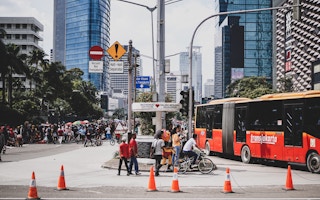As once-in-a-thousand-year floods and heatwaves turn into regular occurrences worldwide, Southeast Asian countries must ask whether they are prepared for worst-case scenarios. Today’s disasters result from decades of carbon accumulation that will inevitably worsen climate crises. Climate adaptation must clearly be prioritised in the face of these realities.
At the same time, the magnitude and frequency of weather extremes suggest that adaptation can never keep up with the escalating danger. Climate mitigation — essentially, the reduction of greenhouse gas emissions — is an imperative that should operate in tandem with adaptation. Southeast Asia must concertedly prioritise climate resilience involving both adaptation and mitigation.
As a first step in building resilience, countries should invest in better data and formulate strategic management plans. The most authoritative evidence points to rising global sea levels as Southeast Asia’s biggest climate worry. Singapore, for example, has seen a 14 cm rise since 1970. Data on sea level changes across the region are far less systematic, but there are ample indications that higher temperatures and rising sea levels, together with land subsidence in coastal cities, are wreaking havoc. A one per cent increase in temperature could hike food production costs by 0.5-0.8 per cent in Southeast Asia. The Philippines, Indonesia, Vietnam, and Myanmar have seen large numbers of people displaced due to natural calamities.
Climate adaptation needs to be managed strategically, responding to the multiple challenges, from handling sea level rise to strengthening social resilience in order to maintain household and community cohesion through the adversities. Most measures complement each other, but some problems present distinct either-or options, for example, building protective barriers versus re-locating affected activities. Adaptation must also include nature-based solutions, such as cultivating mangroves to preserve coastlines, which are less costly.
“
Southeast Asia has some ways to go in climate adaptation but falls short more acutely in climate mitigation.
Strategic management of water and food security must be accorded the highest priority, given that these most essential needs are being destabilised by global warming. Water needs to be collected, stored and distributed efficiently, and conserved in lean times. Countries may need to use newer, more innovative means such as rainwater harvesting, treatment of used water, and seawater desalination, which have been practised in Singapore.
Singapore is a strong example worldwide for adaptation efforts. Its Green Plan 2030 adopts a whole-of-government approach to resource management and seeks to expand green spaces, cut solid and water wastage, expand public transportation, and switch from polluting fuels to cleaner alternatives. For the needed scale of green investments, however, government initiatives need the buy-in from the public and partnerships from the business community.
Building resilience, while daunting, can draw on innovative experiments and new best practices. China’s “sponge cities” represent an urban model for flood management, addressing drainage problems caused by concrete and asphalt covering surfaces. Singapore is incorporating some of these elements. However, China’s water management designs were based on rainfall patterns three decades prior to 2014, which understated today’s climate impacts. The inadequacy of the current framework for climate change-driven weather extremes underscores the value of stress testing urban systems against growing dangers — based on better data and disaster management.
Newer and less water-intensive agricultural practices, like drip irrigation, should be promoted, together with support for farmers to switch to climate-resistant crop varieties. Reduction in wastage along the supply chain is also paramount, with one third of world food produced — about 1.3 billion tonnes — lost annually. Some agricultural spoilage is inevitable, but in Thailand, about 70 per cent of cassava crop loss occurs during the harvest and post-harvest stages, while in India, only 10 per cent of perishable food has cold storage, causing a 30 per cent loss of fruits and vegetables.
Southeast Asia has some ways to go in climate adaptation but falls short more acutely in climate mitigation. The region experienced some five per cent economic growth per year over the past decade, but electricity demand expanded by six per cent, most of it met by fossil fuels. Polluting fuels are used to generate some 75 per cent of Southeast Asia’s electricity, with coal the largest at around 50 per cent. The region’s fast growing share in global emissions and declared interest in decarbonisation should spur more investment in wind, solar and other renewable energy sources.
The dire climate trajectory and high stakes of calamity in Southeast Asia ought to sound a clarion call for a transformational change that prioritises climate resilience through both adaptation and mitigation. National budgets will also need to increase allocations for these purposes, while also demanding that the developed countries deliver on climate finance. Of the amounts promised to developing countries, only a paltry sum has been paid. Moreover, poorer countries need to spend proportionately more on climate adaptation. One estimate puts the global average for adaptation at 0.25 per cent of GDP per year, with most poorer countries needing to spend in excess of one per cent, and up to 20 per cent. Unfortunately, actual spending falls woefully short.
The crucial factor of political will also faces perennial deficit. The rewards of futuristic investments take time to accrue and politicians everywhere are more attracted to policies that yield immediate payoffs. But unlike various democracies, Southeast Asia has yet to see environmental politics enter the mainstream. Society may well have to take the lead in generating a groundswell of public opinion — bolstered by data, knowledge sharing and education campaigns — that presses the political class to act.
Vinod Thomas is currently Visiting Senior Fellow at the ISEAS - Yusof Ishak Institute, and previously Visiting Professor at National University of Singapore. He is a Distinguished Fellow in Development Management at the Asian Institute of Management, Manila, and a member of the advisory panel on climate change at CSEP, New Delhi.
This article was first published in Fulcrum, ISEAS – Yusof Ishak Institute’s blogsite.


















